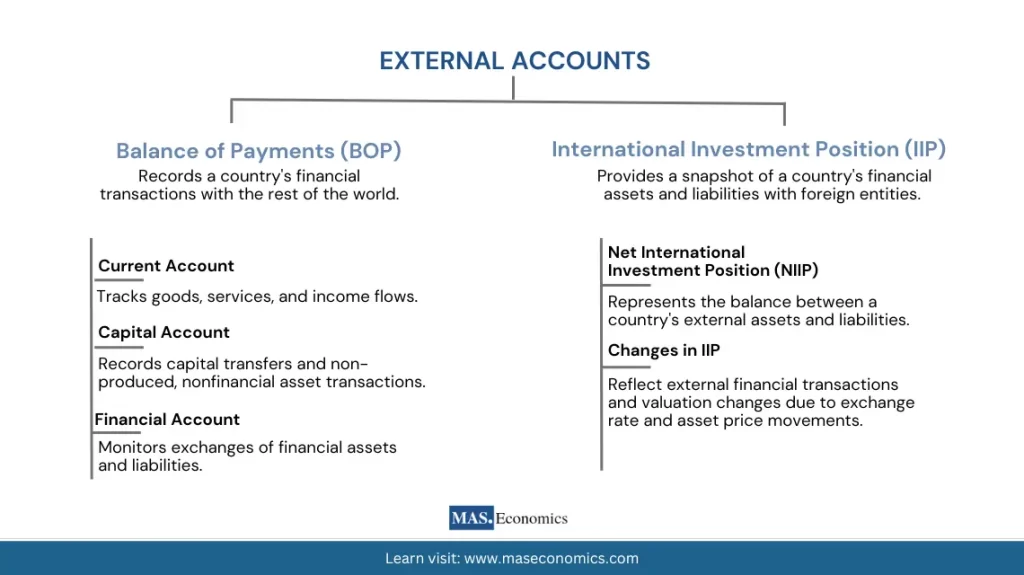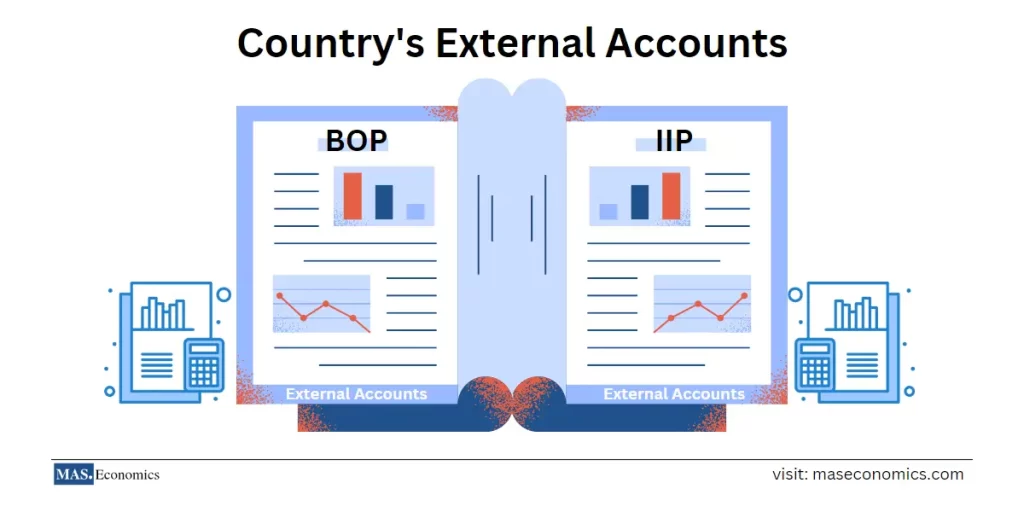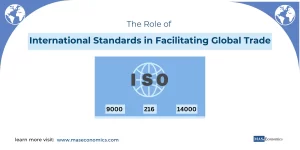External accounts are essential for understanding the financial transactions between countries and their impact on exchange rates, interest rates, asset prices, and economic stability. In this article, we’ll explore the key components of external accounts and their significance in global financial flows.
The External Accounts
External accounts encompass three main components: the balance of payments (BOP), the international investment position (IIP), and changes in financial assets and liabilities. These accounts document transactions between a country’s residents and foreign entities, tracking their external assets and liabilities. Understanding these accounts is crucial for policymakers, international capital market players, and financial institutions in making informed decisions.

The Balance of Payments (BOP)
The balance of payments is a comprehensive record of a country’s financial transactions with the rest of the world. It consists of three main accounts: the current account, the capital account, and the financial account.
The Current Account
The current account tracks the goods, services, and income flow between a country and its trading partners. It includes:
Exports and imports of goods and services: This component measures the value of goods and services traded between a country and its partners. Exports are recorded as credits, while imports are recorded as debits. The difference between exports and imports is the trade balance, a vital indicator of a country’s competitiveness and economic health.
Primary income: Primary income consists of compensation for labor, rental earnings from natural resources, and returns on financial assets or liabilities. This includes wages foreign workers earn, dividends paid to foreign investors, and interest payments on international loans.
Secondary income: Secondary income encompasses cash transfers, gifts in kind, and contributions to international organizations. Examples include remittances sent by foreign workers to their home countries, foreign aid, and donations to global charities.
The current account balance is a crucial indicator of a nation’s economic imbalance. A current account surplus indicates that a country accumulates foreign assets and grows its net international investment position (NIIP). Conversely, a current account deficit suggests that a country is issuing liabilities acquired by foreign entities, decreasing its net IIP.
The Capital Account
The capital account records capital transfers and the acquisition or disposal of non-produced, nonfinancial assets.
Capital transfers include investment grants, debt forgiveness, and transfers of fixed asset ownership. Non-produced, nonfinancial assets include land, subsoil resources, patents, copyrights, and leases.
Investment grants typically require the recipient (public or private) to use the funds for fixed capital formation, such as infrastructure projects or the construction of schools and hospitals.
Debt forgiveness occurs when a creditor voluntarily cancels all or part of a specified debt, relieving the debtor of the obligation to repay.
Acquisition and disposal of non-produced, nonfinancial assets: This category tracks the exchange of assets such as land, subsoil resources, patents, copyrights, trademarks, franchises, and leases between residents and non-residents.
The Financial Account
The financial account tracks the exchange of financial assets and liabilities between residents and non-residents. It classifies these exchanges based on the type of investment (direct, portfolio, or other), original maturity (long or short term), and the issuer or holder (private or public sector). The main categories in the financial account are:
Direct investment occurs when an investor from one economy obtains control or significant influence over a business in another economy. This can be achieved through purchasing an existing firm (brownfield investment) or establishing a new venture (greenfield investment). Direct investment is further classified into outward direct investment (when a domestic investor acquires control of a foreign firm) and inward direct investment (when a foreign investor acquires control of a domestic firm).
Portfolio investment: Portfolio investment involves the buying and selling of stocks, bonds, money market debt instruments, and tradable financial derivatives between non-residents. Unlike direct investment, portfolio investment does not grant the investor control over the company’s management rights. The duration of the exchange identifies the nature of the portfolio investment.
Other investments: Other investments include trade credits, loans, insurance products, pension plans, and standardized guarantees. These investments are usually used to finance current account surpluses resulting from increased foreign financial assets domestic residents hold. Short-term bank loans played a significant role in the economic problems some emerging market economies faced in the 1990s.
Reserve assets: Reserve assets are used to finance current account surpluses and are held by central banks to intervene in foreign exchange markets, manipulating exchange rates and macroeconomic conditions. Adequate management of reserve assets is crucial to ensure sufficient liquidity and prevent severe economic disruptions caused by large capital outflows.
The International Investment Position (IIP)
The international investment position provides a snapshot of a country’s financial assets and liabilities held with foreign entities at a specific time. The net international investment position (NIIP) represents the balance between these assets and liabilities, indicating the country’s external financial wealth. Changes in the IIP reflect external financial transactions from the BOP and valuation changes due to exchange rate and asset price movements.
The IIP is compiled at the end of each quarter or year, and changes in the IIP offer insights into a country’s external financial health. A net increase in foreign assets due to exports results in a more positive net IIP, while a net increase in foreign liabilities due to imports leads to a more negative net IIP. The willingness of foreign residents to acquire domestic assets is limited, which can have implications for exchange and interest rates.
The Importance of External Accounts
Accurate and up-to-date data on a country’s external accounts is essential for economic decision-making. The balance of payments and the international investment position offer valuable insights into a country’s economic performance and role in the global economy. These accounts help policymakers, investors, and financial institutions to:
Assess a country’s economic imbalances and vulnerabilities: External accounts help identify potential risks from sizeable current account deficits, excessive external debt, or a deteriorating net international investment position.
Monitor the sustainability of external debt: The IIP provides information on a country’s external debt levels and its ability to service it. High external debt levels relative to GDP or exports can signal potential debt sustainability issues.
Evaluate the effectiveness of monetary and fiscal policies: External accounts offer insights into how monetary and fiscal policies impact a country’s external competitiveness, capital flows, and exchange rates.
Make informed investment decisions: Investors use external accounts to assess a country’s economic fundamentals, attractiveness as an investment destination, and potential risks associated with investing in a particular economy.
Contribute to global economic stability: External accounts help identify global imbalances and potential sources of financial instability, allowing policymakers to take corrective actions and promote global economic stability.
Conclusion
External accounts offer valuable insights into economic performance, external vulnerabilities, and the impact of policies on the global economy. As the world becomes increasingly interconnected, the importance of external accounts in shaping economic decisions and promoting global stability will only continue to grow.
Governments use these accounts to formulate and evaluate economic policies, while investors use them to guide investment strategies. International financial institutions, such as the International Monetary Fund (IMF) and the World Bank, use external accounts to monitor global economic health and support countries facing difficulties with the balance of payments.
Thanks for reading! If you found this insightful, share the knowledge with friends and spread it on social media!
Happy learning with MASEconomics




